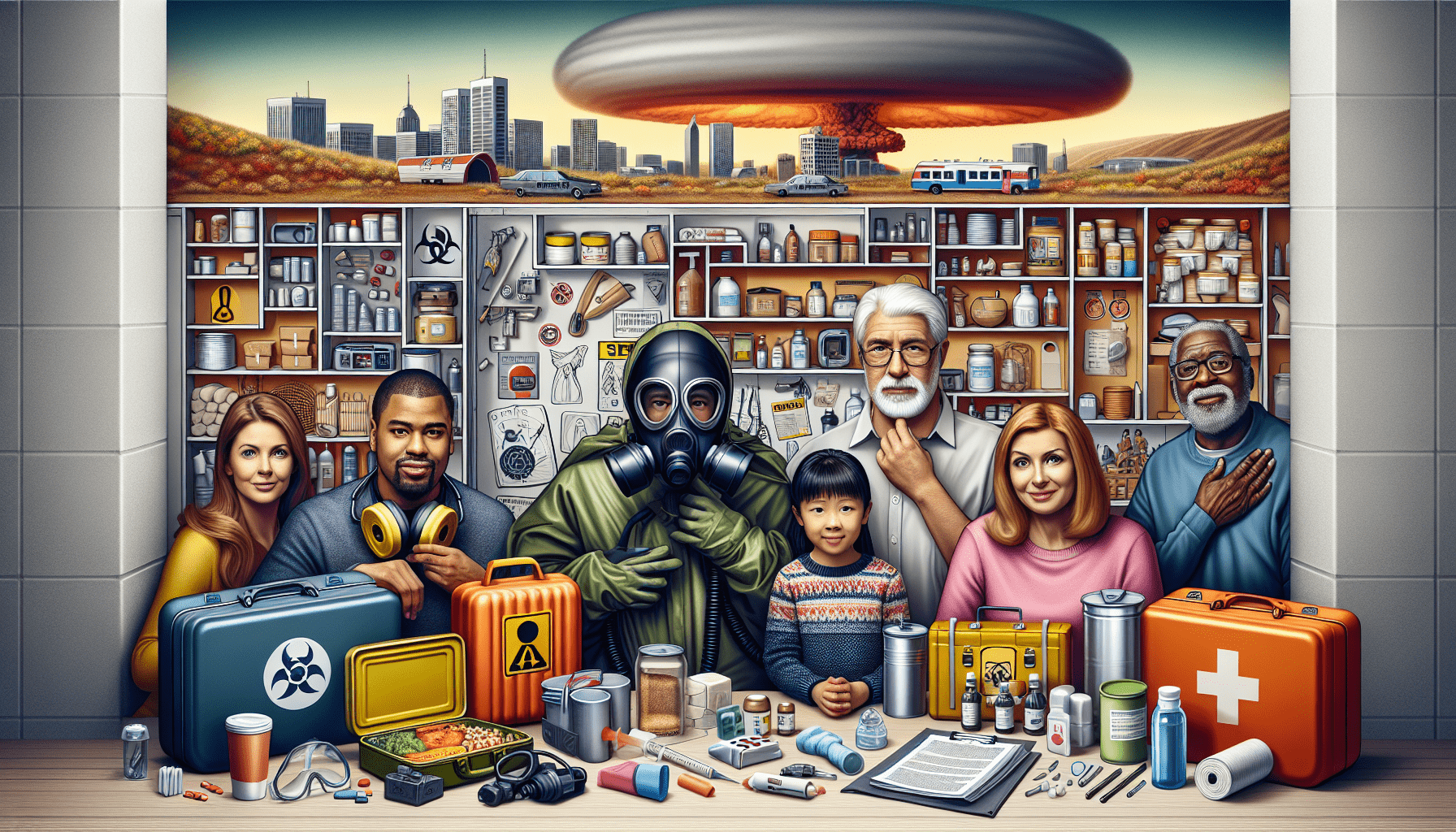In the uncertain world we live in, being prepared for any emergency is crucial. As a prepper, there are specific steps you can take to ensure you are ready for chemical emergencies. From educating yourself about different types of hazardous materials to assembling a well-stocked emergency kit, this article will guide you through the top ways to prepare for chemical emergencies. By implementing these strategies, you can enhance your safety and protect yourself and your loved ones in the event of a chemical crisis.
Create a Chemical Emergency Plan
Identify potential chemical hazards in your area
The first step in creating a chemical emergency plan is to identify the potential chemical hazards in your area. Research the industries, transportation routes, and any nearby facilities that handle or store chemicals. Consult local emergency management agencies and environmental organizations for information on chemical hazards specific to your region. By understanding the types of chemicals that could pose a risk, you can better prepare and respond in case of an emergency.
Designate a meeting point for your family
In the event of a chemical emergency, it is crucial to have a designated meeting point for your family. This meeting point should be easily accessible and outside the potential danger zone. Choose a location that is familiar to everyone, such as a neighbor’s house or a nearby park. Ensure that all family members are aware of the meeting point and instruct them to go there immediately in case of an emergency.
Establish communication methods
Communication is key during an emergency situation. Establish a communication plan for your family to ensure that everyone can stay in contact and receive updates. Consider using multiple methods such as phone calls, text messages, and social media platforms. Additionally, designate an out-of-state contact person who can serve as a central point of communication in case local networks are disrupted. Make sure to share contact information with all family members.
Create an emergency contact list
Compile a comprehensive emergency contact list that includes important phone numbers for local emergency services, poison control centers, hospitals, and other relevant organizations. Keep a printed copy of this list in your emergency kit and store digital copies or back them up in cloud storage. It is also advisable to include emergency contact information for family members, friends, and neighbors who can provide support during a chemical emergency.
Build a Chemical Emergency Kit
Include personal protective equipment (PPE)
When preparing for a chemical emergency, it is essential to include personal protective equipment (PPE) in your emergency kit. This may include items such as goggles, gloves, masks (specifically designed for chemical protection), and disposable coveralls. Choose PPE that offers appropriate protection against the potential chemical hazards in your area. Ensure that all family members have properly fitted PPE and that they know how to use it effectively.
Pack necessary medications
If you or any family member relies on medication, make sure to include an ample supply in your emergency kit. Check the expiration dates regularly and rotate the medications as needed. It is also beneficial to keep a list of medications and their dosages, along with instructions for administering them, in case you need assistance from medical personnel during an emergency. Remember to include any specific medications required for chemical exposures, such as antidotes or decontamination solutions.
Store a supply of emergency food and water
In any emergency situation, having an adequate supply of food and water is crucial. In the case of a chemical emergency, it is essential to store non-perishable food items and at least three days’ worth of water per person. Choose food items that do not require cooking or refrigeration and select water that is stored in FDA-approved containers. Regularly check and rotate your emergency food and water supplies to ensure freshness.
Include a first aid kit with supplies for chemical exposure
A well-stocked first aid kit is an essential component of your chemical emergency kit. In addition to the basic first aid supplies like bandages, antiseptics, and pain relievers, it is important to include items specifically for chemical exposure situations. These may include chemical neutralizers, burn dressings, eye wash solutions, and decontamination materials. Familiarize yourself and your family with the use of these specialized supplies to effectively respond to chemical emergencies.

Educate Yourself about Chemical Hazards
Research common chemical hazards
Take the time to research and educate yourself about the common chemical hazards in your area. Understand the types of chemicals used or transported through your community, as well as their associated risks. Local environmental organizations, government agencies, and emergency management teams are valuable sources of information. By becoming familiar with these chemical hazards, you can make informed decisions and take proactive measures to protect yourself and your family.
Understand their health effects
It is essential to understand the potential health effects caused by different chemicals. Research and gather information about how these chemicals impact the human body and the symptoms to watch out for in case of exposure. Some chemicals can cause respiratory problems, burns, or even long-term health issues. By knowing the health effects, you can take appropriate precautions, seek medical help when necessary, and minimize the risks associated with chemical exposure.
Learn how to recognize chemical releases
Being able to recognize the signs of a chemical release is crucial for prompt action and safety. Familiarize yourself with the visual and olfactory cues that may indicate a chemical emergency, such as unusual odors, vapor clouds, or visible leaks. Pay attention to warning signs, alarms, or notifications from local authorities. The quicker you can identify a chemical release, the faster you can initiate your emergency plan and protect yourself and your family.
Identify safe evacuation routes
Knowing the safe evacuation routes in your area can be lifesaving during a chemical emergency. Research and map out the primary evacuation routes as well as alternative routes in case of road closures or congestion. Take note of designated evacuation assembly points and shelters. Share this information with your family members and practice evacuation drills regularly to ensure everyone is familiar with the routes and procedures.
Practice Evacuation Drills
Conduct regular fire drills
While fire drills are common, it is important to include chemical emergency scenarios in your evacuation drills. Set aside time to simulate a chemical emergency, ensuring that everyone in your household knows how to safely evacuate and assemble at the designated meeting point. Practice using your personal protective equipment correctly and efficiently. Regular drills will help build muscle memory and reduce panic during a real emergency situation.
Ensure everyone knows evacuation routes and procedures
During evacuation drills, emphasize the importance of knowing evacuation routes and procedures. Make sure that all family members, including children, are aware of the primary and alternative routes, assembly points, and any specific instructions related to chemical emergencies. Consider assigning one family member to be responsible for leading the evacuation drills and ensuring that everyone has successfully evacuated to the designated meeting point.
Designate a safe location to meet outside your home
In addition to practicing evacuation drills within your own house, it is crucial to designate a safe location outside your home to meet in case of a chemical emergency. Choose a spot that is easily accessible and away from the potential danger zone. This location should be agreed upon and known by all family members. When gathering at the designated spot, do a headcount to ensure that everyone is present and accounted for.

Secure Your Home from Chemical Exposure
Seal windows and doors with plastic and duct tape
To minimize the risk of chemical exposure, it is advisable to seal windows and doors with plastic and duct tape in case of a chemical emergency. This helps create a barrier that can prevent hazardous chemicals from entering your home. Keep a supply of plastic sheeting and duct tape in your emergency kit for this purpose. Regularly check the condition of the seal and replace it as needed to ensure its effectiveness.
Install a ventilation system with activated carbon filters
Consider installing a ventilation system equipped with activated carbon filters to help reduce the infiltration of chemicals into your home. Activated carbon filters are efficient in trapping and removing harmful chemicals from the air. Consult with HVAC professionals to determine the best ventilation system suitable for your home and the specific chemical hazards in your area. Regularly maintain and replace filters as recommended by the manufacturer.
Use chemical-resistant materials for building or renovating
If you are building or renovating your home, consider using chemical-resistant materials. These materials are designed to be less permeable to chemicals, providing an added layer of protection in case of a chemical emergency. Consult with architects, builders, or contractors who are knowledgeable about chemical-resistant building materials. By incorporating these materials into your home, you can reduce the risk of chemical exposure to you and your family.
Keep chemical storage areas separate from living spaces
If you store chemicals in your home, it is crucial to keep them separate from living spaces. Designate a specific area, preferably an isolated and well-ventilated room or a dedicated storage cabinet, for storing chemicals. Ensure that these storage areas are properly labeled, secure, and equipped with spill containment measures. Keeping chemicals separate from living spaces reduces the chances of accidental exposure during a chemical emergency.
Learn Decontamination Procedures
Understand the decontamination process for different chemicals
Different chemicals require different decontamination procedures. It is essential to understand the specific decontamination process for the chemicals prevalent in your area. Research and familiarize yourself with the recommended decontamination techniques, such as washing with soap and water, rinsing with saline solution, or using specific decontamination agents. Knowing how to effectively decontaminate yourself and your family can help minimize the health risks associated with chemical exposure.
Learn how to properly remove contaminated clothing
In the event of chemical exposure, contaminated clothing can continue to expose you to harmful chemicals. Learn how to properly remove contaminated clothing safely to minimize further contact and potential health risks. It is advisable to practice this technique during non-emergency situations to ensure that you and your family members are familiar with the steps and can carry them out efficiently when needed.
Practice decontamination techniques with household items
While professional decontamination supplies may not always be readily available during a chemical emergency, you can practice decontamination techniques using household items. For example, practice rinsing with running water for at least 15 minutes to flush chemicals from the skin, or using mild detergents to wash off chemical residues. This familiarity with decontamination techniques using household items can be useful in situations where professional help is not immediately accessible.
Know when to seek professional medical help
Understanding when to seek professional medical help is crucial in the event of a chemical emergency. Certain chemicals may require immediate medical attention due to their severe health effects. If you or anyone in your family experiences symptoms related to chemical exposure, such as difficulty breathing, severe burns, or acute changes in mental status, call emergency services immediately. Familiarize yourself with the local poison control center’s contact information and reach out to them for guidance if needed.

Stay Informed
Monitor local news and emergency alerts
Stay informed about potential chemical emergencies by monitoring local news and emergency alerts. Regularly check news outlets, websites, or social media platforms for updates on chemical incidents or emergency situations in your area. Sign up for text or email alerts from local authorities or emergency management agencies to receive real-time information about any ongoing chemical emergencies or related safety instructions.
Sign up for community emergency notification systems
Many communities have emergency notification systems in place to keep residents informed about potential hazards. These systems may include automated phone calls, text messages, or email alerts. Sign up for these community emergency notification systems to ensure that you receive timely and accurate information about chemical emergencies in your area. Stay connected and promptly follow any instructions provided by local authorities or emergency management agencies.
Follow government agencies and organizations specializing in chemical emergencies
To stay updated on chemical emergency preparedness and response, it is advisable to follow government agencies and organizations specializing in chemical emergencies. These include agencies such as the Environmental Protection Agency (EPA), the Centers for Disease Control and Prevention (CDC), and the Occupational Safety and Health Administration (OSHA). By following their websites, social media accounts, and subscribing to their newsletters, you can access valuable information regarding chemicals, safety standards, regulations, and best practices.
Stay updated on chemical safety standards and regulations
Chemical safety standards and regulations are regularly updated to ensure the protection of individuals and the environment. Stay informed about these updates by regularly reviewing relevant websites and publications. Familiarize yourself with safety guidelines and regulations applicable to your area and industry. By staying updated on chemical safety standards, you can make informed decisions, implement necessary safety measures, and contribute to a safe and prepared community.
Develop a Community Response Network
Collaborate with neighbors to create an emergency response network
Collaborating with your neighbors to create an emergency response network can greatly enhance your preparedness for chemical emergencies. Establish a network of neighbors who are willing to support and assist each other during emergencies. This collaborative effort can involve sharing resources, skills, and knowledge to ensure the safety and well-being of the entire community. Regularly communicate and organize meetings to discuss emergency plans, share information, and address any concerns.
Share resources and knowledge about chemical safety
In a community response network, it is essential to share resources and knowledge about chemical safety. Pool together essential emergency supplies, such as PPE, first aid kits, and emergency food and water. Share information about common chemical hazards, evacuation routes, and decontamination procedures. By leveraging the collective resources and knowledge within the community, everyone can benefit from increased preparedness and a more effective response to chemical emergencies.
Organize training sessions and workshops on chemical emergency preparedness
Organize training sessions and workshops within your community to educate residents about chemical emergency preparedness. These sessions can cover topics such as recognizing chemical hazards, understanding health effects, decontamination techniques, and proper use of personal protective equipment. Engage professionals from relevant fields, such as emergency management or environmental health, to conduct these training sessions and provide expert guidance. By empowering community members with knowledge and skills, you are building a stronger and resilient community.
Establish a communication system during emergencies
Establishing a communication system within your community is vital during chemical emergencies. Identify methods of communication, such as walkie-talkies, social media groups, or messaging apps, that can be used when traditional communication channels are disrupted. Designate individuals within the community who can serve as communication liaisons during emergencies, disseminating information and updates to the rest of the community. A robust communication system can facilitate coordination, support, and resource sharing within the community during a chemical emergency.

Consider Alternative Shelter Options
Identify nearby buildings or shelters with better protection
In the event of a chemical emergency, it may be necessary to consider alternative shelter options with better protection. Identify nearby buildings or shelters that offer enhanced protection against chemical exposure, such as hospitals, schools, or community centers. These facilities may have better ventilation systems, air filtration, or designated safe rooms. Familiarize yourself and your family with the locations and access procedures of these alternative shelter options.
Explore community resources like schools or community centers
Community resources like schools or community centers can play a crucial role during chemical emergencies. Reach out to local schools or community centers to inquire about their emergency plans and available resources. Determine if these facilities can serve as temporary shelters or provide support services during a chemical emergency. Collaborate with these institutions to strengthen the community’s preparedness and response capabilities.
Research portable shelters or safe rooms for chemical emergencies
For added preparedness, consider researching and investing in portable shelters or safe rooms specifically designed for chemical emergencies. These structures provide a highly controlled environment, minimizing the risk of chemical exposure. Portable shelters and safe rooms come in various sizes and designs, and they can be used both in residential and commercial settings. Evaluate the available options and consult with professionals to determine the most suitable shelter for your needs.
Create a plan for relocating to a safer location if needed
It is essential to have a plan in place for relocating to a safer location if the situation warrants it during a chemical emergency. Identify nearby areas or towns that are less likely to be affected by the potential chemical hazard. Determine the best routes to reach those areas and consider any necessary supplies or resources that might be needed for relocation. By having a well-thought-out plan, you can act promptly and ensure the safety of yourself and your family.
Stay Healthy and Physically Fit
Maintain a healthy lifestyle and exercise regularly
Maintaining a healthy lifestyle and engaging in regular exercise can contribute to your overall preparedness for a chemical emergency. A healthy body and mind are better equipped to handle stress and adapt to emergency situations. Prioritize a balanced diet, regular exercise, and adequate sleep. By taking care of your physical and mental well-being, you can increase your resilience and readiness to face challenging times.
Ensure your vaccinations are up to date
Keeping your vaccinations up to date is crucial in any emergency situation, including chemical emergencies. Certain chemicals may weaken the immune system or make individuals more susceptible to infections or diseases. Stay current with recommended vaccines, and consult with healthcare professionals for any specific vaccines recommended for chemical exposures. By maintaining up-to-date vaccinations, you can help protect yourself and your family from additional health risks during a chemical emergency.
Practice personal hygiene to minimize contact with chemicals
Practicing good personal hygiene habits can help minimize your contact with chemicals during an emergency. Wash your hands regularly and thoroughly with soap and clean water, especially before eating or touching your face. Avoid touching surfaces that may be contaminated with chemicals. If exposure occurs, follow proper decontamination procedures promptly. By making personal hygiene a priority, you can reduce the risk of chemical absorption or ingestion.
Prepare for psychological impact and stress management during emergencies
Chemical emergencies can have a significant psychological impact on individuals and communities. It is essential to prepare for this aspect of emergencies as well. Familiarize yourself with stress management techniques, such as deep breathing exercises, meditation, or engaging in hobbies that help you relax. Stay connected with your support network and seek professional help if necessary. By addressing the psychological impact, you can better cope with the stress and emotional challenges that may arise during a chemical emergency.
Preparing for chemical emergencies as a prepper requires a comprehensive approach that encompasses various aspects of readiness. By creating a chemical emergency plan, building an emergency kit, understanding chemical hazards, practicing evacuation drills, securing your home, learning decontamination procedures, staying informed, developing a community response network, considering alternative shelter options, and maintaining your health and well-being, you can greatly increase your preparedness and ability to respond effectively in case of a chemical emergency. Stay safe, be prepared, and empower yourself and your family to navigate through challenging times.

